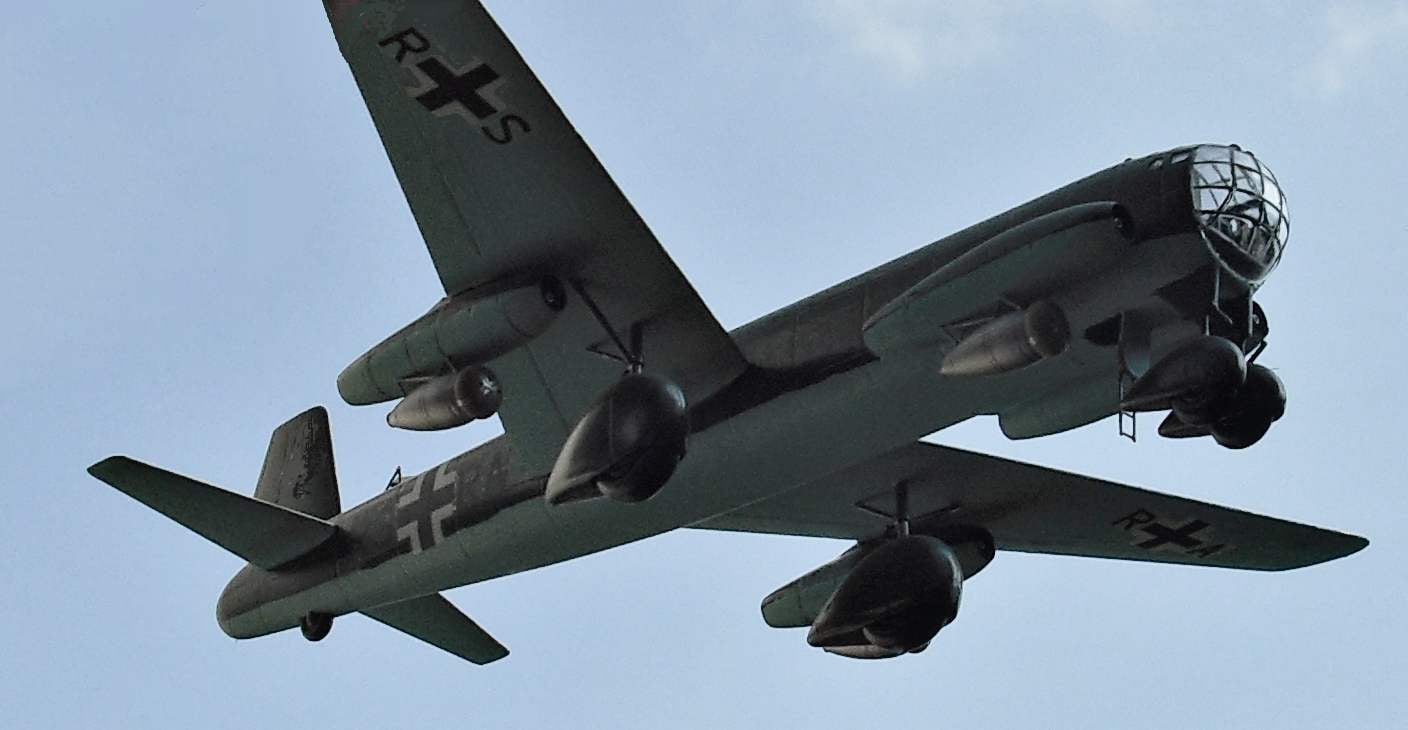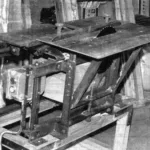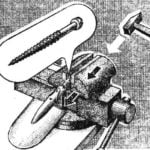 Some of the development of German designers during the Second world war continue to surprise the experts to this day. These include the creation of jet Sukhoi company “Junkers”.
Some of the development of German designers during the Second world war continue to surprise the experts to this day. These include the creation of jet Sukhoi company “Junkers”.
For reduction of terms of designing it based on the airframe of a piston aircraft Ju-177, but with forward-swept wing. It is difficult to say why the German designers have chosen this form the bearing surface, but, of course, by the time they knew many of the positive and negative sides of these wings. It can be assumed that the choice of the specialists of the company “Junkers” was associated with the desire to maintain a structurally-power circuit of the fuselage Ju-177 with it’s huge cargo compartment and does not alter the cockpit. So there was a plane Ju-287 with forward-swept wing with an angle of 16° to the front edge. His remains have caught the attention of Soviet aviation specialists on the German airfield Brandis.
Last option is jet V3 Junkers — Ju-287 was the basis for the future of the EF-131, engineered under the direction of B. Baade (former technical Director of the company “Junkers”), Development started in the end of 1945 in Germany, in territory controlled by Soviet troops and, apparently, at the initiative of the NCAP. In April of the following year was issued a corresponding decree of the USSR government officially sanctioned the creation of this machine.
In the summer of 1946 in the German city of Dessau under the leadership of Lieutenant General V. A. Ushakov worked prototyping Commission in plane EP-131 with six Jumo 004. This Commission was quite representative. In addition to the Deputy Minister of aviation industry M. M. Lukin and member of the technical Committee of the customer, it was part of the GK NII VVS renowned specialist in the field of aerodynamics V. S. Pyshnov, test pilot M. A. Nutico, test-Navigator.GN P.The flowers and the engineer L. I. Moose.
It seems that the machine produced to the Commission a strong impression. And I was right: after the great Patriotic war was little more than a year in the Soviet Union by the time of creating a jet bomber, such as the EP-131, flying at a speed of 860 km/h at the distance of 1710 km, could only dream of. However, takeoff and landing characteristics required of aerodrome with a runway length of at least 2000 m. Although if you want the run can be reduced to one kilometer, but in this case required a start-up rocket boosters.
Research conducted in wind tunnels of TSAGI under the leadership of future academician V. strutinskogo showed that aircraft with forward-swept wing (with an angle of 30° to the front edge) can reach the speed corresponding to the Mach number = 0,9 — 0,95, while maintaining the necessary characteristics of stability and controllability. This conclusion was supported by the results of the studies carried out on a flying laboratory LL-3, created in the design Bureau of P. V. tsybina.
In practice, though, as it turned out, it was much more difficult. To create a sufficiently rigid structure of the wing then the German specialists had failed, and had another AI-287, greatly reduce the sweep angle. But here, the designers met with several difficulties that eventually led to the cessation of work in this direction.
A bomber crew of the EP-131 consisted of three people and housed in a common sealed cabin ventilation type with no elements of damage. To call a cab sealed can only be conditional, because as you climb, starting from 3200 m, the pressure decreased and the difference was maintained at 250 mm Hg. article
As noted by the mock-up Committee, because distinct from domestic aircraft functional responsibilities of the members of the crew of the EP-131 arrangement of devices and equipment in the cockpit resulted in the inability of Navigator on navigation and he needed the help of the arrow-radio operator.
All-in-one throughout the length of the fuselage had an oval cross-section. In its middle part, immediately behind the cockpit, was located freight (air) compartment length 5.2 m, containing up to 4000 kg bombs. It was a five fuel tanks with a total capacity of 8700 L. If necessary, the fuel supply was increased at the expense of two external fuel tanks in the bomb Bay. In the rear fuselage had a brake parachute.
The cargo Bay was designed for German ammunition, but it would freely put up to 32 bombs FAB-100, 12 — FAB-250-M46, nine — FAB-500-M46 and a pair of FAB-1500-M46. However, the German designers refused to modify the car with the bomb racks, citing a lack of time. The aircraft was provided for the Lotfe sight-7H-2, which permitted the bombing in ground speed in the range from 200 to 1000 km/h.
Defensive armament consisted of two remote-controlled machine gun MG 131 13 mm caliber on the aft installing KUFNL-131 (angles of attack with the vertical 45° up and down and in the horizontal plane at 60° to the sides) with a periscopic sight PVE-11. However, the mock-up Committee considered defensive weapons of the weak and recommended replacing it three Soviet mechanized units under the guns of calibre of 20 — 23 mm two-gun turrets for protection top and rear hemispheres, and one or two guns firing forward.


Airplane EF-131:
1 — the pilot seat; 2 — the dashboard Navigator; 3 — seat radioman; 4 — the co-driver seat; 5 — door; 6 — upper escape hatch; 7 — periscope sight PVE-11; 8 — remote upravlennya infantry unit; 9 — drive units of the rear remote infantry unit; 10 is a shaft drive tail, remote infantry unit; 11 — tail of small, remote install FHL-131; 12 — cartridge box; 13 — sleeve a supply of rounds; 14 — the first fuel tank with a capacity of 2000 liters; 15 — second fuel tank with a capacity of 2000 liters; 16 is the third fuel tank capacity 2000 l; 17 — the fourth fuel tank capacity of 1100 liters; 18 — the fifth fuel tank capacity 1600 l.; 19 — tail ANO (white); 20 — wheel main landing gear in the retracted position; 21 — wheel of the nose landing gear in the retracted position; 22 — bomb SC-250; 23 — the mechanism of opening of the valves of the bomb Bay; 24 — doors of the bomb Bay in the open position; 25 — hatch storage box; 26 — PVD; 27 — right ANO (green); 28 — gyrocompass; 29 — propellant start-up accelerator; 30—brake parachute; 31 — additional fuel tanks (2×1115 L.); 32 — left ANO (red)
The forward-swept wing with an angle of 19°50′ line of magic tricks and provided with a flap type “Junkers” had the aerodynamic twist: the setting angle at the root was equal to 2°,. a distance of 4,685 m — 0.5°, the next to the end of the wing is constant.
For the main landing gear suggested the use of wheel dimensions mm 1440×520 borrowed from an American bomber b-24 “liberator” company “consolidated”.
For communication with the earth, and navigation used the radio station FUG-10R, and to transmit commands in the air — radio FUG-16ZU. However, the mock-up Committee was required to replace their domestic RSB-5 and RCI-6, set the radio altimeter type American AN/APN-1, intercom SPU f-5 and other equipment.
In its conclusions, the dummy, the Commission noted that “jet bomber the EF-131, emerging at the airport in September (1946 — Approx. ed.) year, is for the air force interest and can be used for research and development: flight, piloting technique, and gain experience operating jet bombers, due to the special design novelty”. But this conclusion did not mean that, if confirmed in a flight test aircraft specified characteristics, EF-131 will be laid, and group B. Baade dissolved. In the Soviet Union looked forward to the German experts was commissioned to develop a version of the machine under the designation of the aircraft “140”, designed for the use of the engines, ammunition, defensive weapons, equipment and other components of Soviet production.
EF-131 was built in three copies in Germany, then disassembled and brought to the USSR, in the Moscow suburb of Zhukovsky. Two of them are designed for flight testing, got on the airfield Flight research Institute, now named after M. M. Gromov, and the third in TSAGI for static tests.
German aircraft designers due to the lack of powerful engines had to be installed on the EF-131 six ways to build a turbojet engine. Curiously, a month after the return of Soviet experts Home came out a government resolution on the creation of the engine axial compressor turbojet-7B thrust of 3000 kg and an equivalent of AMDG-01. The first of them was designed in a prison design Bureau-2, subordinate to MVD of the USSR, and second in team A. A. Mikulin. AMDG-01 takeoff thrust 3300 kgs (nominal — 3000 kgf) and subsequently installed on the aircraft “140” — the Soviet version of the EF-131.
The first flight of the EF-131, piloted by German pilot Paul Julge was held on may 23, 1947 decree of the Soviet government, the bombers were instructed to pass the state test in July of the same year. But this did not happen.
“Adventure” EF-131 began with the first flight. On the run I broke a bolt traverses the left main landing gear, the plane lurched in the direction of the damaged stands and grating for the lower engine has completed its flight.
Then he felt a “shimmy” — a dangerous oscillation of the nose landing gear, reminiscent of fashion in the 1930-ies dance. Following this, emerged shaking the rear fuselage, besides, the results of the static test airframe in TSAGI was required to strengthen the structure of a number of its units. Almost every flight was denied to one or the other engine, because the reliability and service life of the Jumo 004 left much to be desired. In the end, by October 1947, the car had a chance to rise into the air only eight times.
The basic data of the aircraft with forward-swept wing

The following year, testing continued. The first prototype aircraft performed 15 flights with a total duration of 11 hours. While investigated the characteristics of the machine until a speed of 850 km/h, corresponding to the number M = 0.75, and its takeoff performance to the mass 20 000 kg.
Flew the EF-131 and Soviet test pilots, in particular A. A. Efimov: had a chance to steer and M. L. Gallay.
In June 1948, testing the EF-131 was stopped suddenly, but two months later, when he developed his improved version — the aircraft “140”, flight research bomber with forward-swept wing resumed. By the time the German designers have thoroughly settled in the suburban village of podberez (now Dubna). Deputy B. Baade was P. N. Obrubov, and overall management of the design Bureau was carried out by S. M. Alekseev.
Compared with the predecessor, the aircraft “140” placed two experienced engine AMDG-01. Machine been pretty strong defensive armament, which included top-VDB-8, and lower NDB-1M, small installation with dual 20-mm guns (probably B-20) with a total ammunition of 1,000 rounds.
Normal bomb load was 1500 kg and 4500 kg. To increase the range in the front sections of the bomb Bay with a length of 5.2 m was provided for the placement of two additional fuel tanks. The crew and the EP-131 was housed in the General, but now quadruple unsealed the cockpit and had the body armor of metal plates with a thickness of 10 to 20 mm. Set another periscope for a review of the upper and lower hemispheres. The wheels of the chassis, as with all equipment, replaced domestic.
The Board of the machine had a radar sight PSBN and altimeter, four cameras and other equipment, without which the fulfillment of combat missions in those years was impossible.
For de-icing in socks wing and tail on the glass of the cockpit crew (pilot and Navigator) used airborne thermal system. There were on Board inflatable rescue boat LAS. To reduce mileage provided for a container of a brake parachute.
The aircraft “140” built in July 1948, using the units of the second instance of experienced bomber EP-131, and transported to the airfield Warm Mill, which now houses one of the districts of Moscow. September 30 Ulge Paul (lead engineer, Kreuter) made the aircraft “140” (sometimes called German style EF-140/.1) first flight.
A factory test car lasted less than five months — until the summer of 1949 During the test failed to reach the height of 11 000 m and to determine runway and Vysokoskorostnye characteristics. It turned out that the flight weight 20 798 kg maximum speed of the bomber did not exceed 902 km/h at an altitude of 5000 m, which corresponds to the number M = 0,776. One reason for the low speed was divergence of the wing, which spontaneously due to lack of hardness, screwed in, increasing the angle of attack.
While the bomber was tested in the USSR, mastered serial production of engines with a centrifugal compressor VK-1, although smaller compared to AMDT-01 traction, but quite reliable. This circumstance gave rise to modified cars, but this time in bomber-time-Vedic “140Б/R” with the crew reduced to three people. The layout of the aircraft presented to the customer in October 1949
When using the plane on the sea theaters of military operations in its cargo Bay could be suspended perspective rocket-propelled torpedoes PAT-52, mines AMD-1000 AMD-500. “140Б/R” could be easily converted in the field in photo reconnaissance. Compared with the predecessor, increased defensive armament. Upper and lower doctor of technical Sciences DTV remote infantry units have planned the use of paired cannons NR-23 23 mm caliber with a total complement of 800 rounds.
The equipment of the machine “140Б/R” included, in particular, the autopilot AP-5, the defendant “Barium-M” (with a possible replacement on “Magnesium”), radio altimeters small and large heights RV-2 and RV-10, automatic radio ark-5, radar PSBN-M. But the bomber scout was not up in the air.
Instead, the option “140Б/R” altered “140V.1”, replacing the engines on the VC-1. In the vast cargo hold of a scout positioned the cameras for day and night shoots. In the fall of 1949, the plane rose into the air, but after a few short flights it was returned to the factory for modification, drawn up in the spring of next year. However, further tests showed that the designers were unable to cope with the vibration and twisting of the wing. In July 1950, all work on the aircraft “140” stopped.
By the time the domestic industry has mastered the serial production of Sukhoi Il-28 and torpedo bomber Tu-14. Both cars had a pressurized cabin for the crew and met the requirements of the air force and Navy aviation. This is especially true for the Il-28, which had large reserves, after allowing for appropriate modifications to extend its functionality.
Comparison of the altitude and speed characteristics shows that the aircraft “140” clearly inferior to the Il-28, and in particular its variant with engines VK-5. Suffice it to say that one of the most important parameters of the aircraft — maximum speed “140V.1” (as already mentioned) does not exceed 902 km/h, and the number “M” does not exceed 0,776 0,78 against the Il-28. In addition, to implement in mass production in Soviet factories bomber, created by the German designers, was a matter of not prestigious.
N. VASILIEV



